Commercial waste diversion - success stories
Many Calgary businesses and organizations are already diverting most of their waste through recycling, composting and other unique initiatives.
Here are some stories to give you ideas and inspiration.
Program resources
Find other online tools, signs and posters, and best practices to help you get started with your diversion programs. See Business Waste Program: Tools and Resources.
You can also subscribe to our waste diversion business newsletter to stay up to date with commercial waste program changes.
Looking for disposal options for business waste items? Find disposal options and instructions at Waste Disposal Options for Business.
The Calgary Zoo
The Calgary Zoo is dedicated to conserving wildlife and inspiring the public to do the same. They have a drive to continually improve operations at the zoo to fuel positive change and environmental stewardship. This proactive approach is helping them becoming a sustainable place to work and visit. So far, the zoo has started green practices such as:
- waste diversion
- energy management
- water use
- green purchasing
- chemical management
- educational programs
- construction management
Reduce Waste, Create Compost
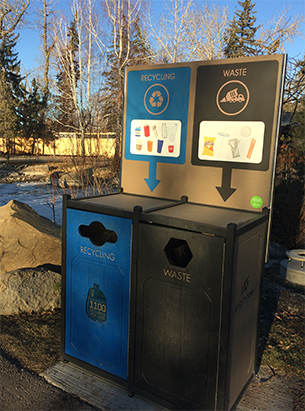 In 2015, they established the Green Team Council, which develop plans for implementing green practices. A waste audit was also done, to reduce landfill garbage. Colour coding for dumpsters helped make the change easy.
In 2015, they established the Green Team Council, which develop plans for implementing green practices. A waste audit was also done, to reduce landfill garbage. Colour coding for dumpsters helped make the change easy.
As 2016 rolled in, a three-stream system (garbage, recycling, and composting) of public waste bins began at the zoo. On Earth Day, they were spread across the 125-acre park near food service areas. Bins were:
- customized with public messaging,
- created of 97% post-consumer waste and,
- 75 existing two-stream bins were retrofitted for use.
The launch of the new bins was during Easter Eggstravaganza— one of the busiest days of the year. The zoo hosted events and games promote the waste reduction changes. 2016 also introduced a park-wide composting program. In 2017, the zoo collected approximately 3,300 kgs of compostable waste.
Building for Sustainability
The zoo also supports sustainable construction projects; they have two Gold Certified LEED buildings and are following new sustainable building guidelines, called Petal Certification. This is to prepare for the giant pandas arrival in spring of this year.
Challenges to Building a Culture of Sustainability
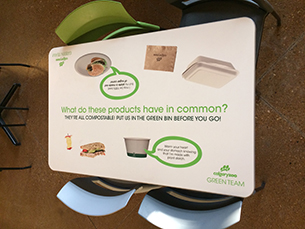 With over 1.3 million visitors a year, it can be difficult to share sustainability with everyone; bin contamination in public areas can be a challenge; however, bin signage has been refined and messaging enforced through internal and external communications channels.
With over 1.3 million visitors a year, it can be difficult to share sustainability with everyone; bin contamination in public areas can be a challenge; however, bin signage has been refined and messaging enforced through internal and external communications channels.
The Green Team webpage shares key green practices and resources for waste diversion. Annual waste audits allow the zoo to track successes and know what’s going to the landfill.
Ongoing training of staff and contractors build sustainability into their culture, semi-annual litter pick ups and feedback surveys create team opportunities and environmental sustainability has become a key in staff performance management.
Successes Achieved
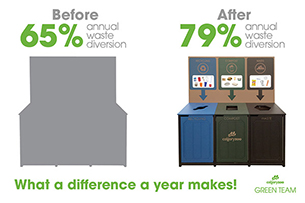 One year after starting three-stream bins, the zoo reduced waste by 50%. This is equal to almost 104,000 kg— or the weight of 87 giraffes. Their waste diversion rate was at 79% — meaning 14% less in the garbage.
One year after starting three-stream bins, the zoo reduced waste by 50%. This is equal to almost 104,000 kg— or the weight of 87 giraffes. Their waste diversion rate was at 79% — meaning 14% less in the garbage.
1,500 kgs of high quality compost produced by composting on site were used on the gardens and grounds.
To date, 99.79% of materials from the Panda Passage renovation have been either repurposed or recycled.
Through the efforts of the Green Team and zoo visitors, The Calgary Zoo is not only sharing a message of conservation and preservation, they’re creating a greener experience for all— animals and humans alike.
NOVA Chemicals
NOVA Chemicals is a leading producer of plastics and chemicals that make everyday life healthier, easier and safer. NOVA Chemicals operates throughout Canada and the United States, including Technology Centres in Calgary. Office waste diversion initiatives take place throughout the company, including an organics and recycling program at Calgary's head office initiated by NOVA Chemicals. This brought their property manager into compliance well before the recycling and organics bylaw effective dates. Below are the highlights of the diversion efforts of the Technology Centres, including the following facilities:
- The Centre for Applied Research (CAR): 155,000 sq. feet, approximately 200 employees
- The Centre for Performance Applications (CPA): 85,000 sq. feet, approximately 80 employees
A foundation for "doing the right thing"
NOVA Chemicals' corporate culture and the enthusiasm of employees have been key elements in implementing waste diversion initiatives. The culture at NOVA Chemicals is rooted in its commitment to Responsible Care® and sustainability. Responsible Care was established by members of the Chemistry Industry Association of Canada to reflect the industry's commitment to sustainability – including the betterment of society, the environment and the economy. NOVA Chemicals was one of the founding members of Responsible Care. NOVA Chemicals' organizational structure includes a number of teams that contribute to fulfilling the company's commitment to Responsible Care.
One of those teams at the Technology Centres is the Taking Care in Action team with the following mandate: Encourage good environmental, health and safety stewardship among NOVA technology employees, contractors and their families. The team is made up of individuals who are enthusiastic about promoting waste diversion and has been heavily involved in implementing and promoting the Technology Centres' waste diversion program.
Office waste diversion initiatives
Between 2013 and 2015, the Technology Centres expanded their basic office recycling programs. These initiatives included increasing the number of recycling stations across the buildings, improving signage, preparing staff communications and conducting an office waste assessment.
Green Calgary performed the office waste audit, which found that 86 per cent of the Techonology Centres' office waste was already being diverted. Of the remaining waste, it found that 98 per cent could be diverted from landfill through existing diversion streams and by implementing an organics diversion program. Organics made up approximately 38 per cent of the remaining waste. Based on the findings, an organics diversion service was implemented in 2015, paper towel recycling was implemented and staff communications were prepared to increase awareness on these topics.
These early diversion initiatives paid off when the Technology Centres received notice of The City of Calgary's recycling and organics bylaws. At the time, CAR and CPA had already met all of the recycling bylaw requirements except for wood pallet recycling, which was implemented in time to adhere to the recycling bylaw in November 2016. When organics diversion became mandatory in November 2017, CAR and CPA had been compliant for over two years.
The Taking Care in Action team continues to work on office waste diversion initiatives. For example, a current initiative is taking a close look at the way lunches and special events are catered so that waste to landfill can be minimized. Further, the team intends to continue offering presentations on the topic of waste diversion to help influence employees behavior.
Program details
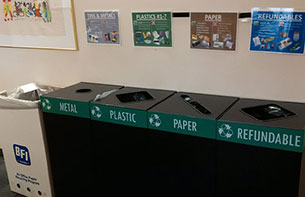
There are seven office recycling stations at CAR and four stations at CPA. Each station has an organics bin and four recycling bins (for metal, plastic, paper and refundable beverage containers). There are paper towel recycling bins in the washrooms and recycling locations for shredded paper, batteries and electronics at each facility. Wood pallet recycling bins are located near the loading dock where most wood pallets are handled. Waste Connections provides the collection services for the majority of their diversion streams, with Urban Impact servicing the organics and some specialized providers for other materials.
Aside from office waste, NOVA produces a large amount of research grade plastic that cannot be recycled with regular post-consumer plastics. For many years, NOVA Chemicals has partnered with a processor of post-consumer and post-industrial plastic to recycle the majority of this material. The remainder of NOVA's research grade plastics that cannot be recycled is used in engineered fuels. NOVA recycles an average of 444 tonnes of experimental plastics annually from their research operations in Calgary.
Key challenges
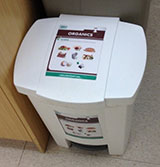 Bin location: Some areas of the office did not have existing space for all of the bins, so they looked for the closest convenient location (such as a hallway) or used smaller freestanding bins. Countertop organics bins are used to optimize diversion at coffee stations. The team knew that they had to make the programs convenient in order for employees to participate.
Bin location: Some areas of the office did not have existing space for all of the bins, so they looked for the closest convenient location (such as a hallway) or used smaller freestanding bins. Countertop organics bins are used to optimize diversion at coffee stations. The team knew that they had to make the programs convenient in order for employees to participate.
Odour of organic bins: Prior to implementing the organics program, there was concern about potential odours from the collection bins. To address this concern, it was communicated to employees that new waste was not being introduced and that the bins would be serviced frequently.
Contamination and adherence to waste diversion: While most employees properly divert their office waste, issues remain with some recyclables and organics going into the garbage can, ultimately designated for the landfill. To address this issue, the Taking Care in Action team prepares two to three presentations per year to all staff to increase awareness, including pictures of items that do not belong in the garbage.
Summary
Waste diversion initiatives at NOVA Chemicals are strongly supported by the company's culture which is rooted in Responsible Care. At CPA and CAR, the Taking Care in Action team has championed many initiatives to implement and promote office waste diversion. These initiatives have included increasing recycling bin locations, conducting an office waste assessment, implementing an organics diversion program and preparing educational presentations aimed at raising awareness and modifying behavior.
Responsible Care® is a registered trade mark of the Chemistry Industry Association of Canada.
The Calgary Board of Education
Since 2008, the Calgary Board of Education (CBE) has made significant strides in reducing their waste and energy use, while at the same time incorporating sustainability principles into their school curriculum.
With more than 225 schools, over 118,000 students and 14,000 employees, rolling out a comprehensive recycling program is not an easy feat for a complex organization.
Their goal
The CBE’s overall waste goal is to reduce waste going to the landfill by 80 per cent by 2020 (from 2007/08 levels).
CBE waste reduction by the numbers
Ninety per cent of CBE schools participate in a centralized recycling program.
Over 27,000 kg of recyclables are collected every month.
Nearly 50 per cent of schools participate in a food and yard waste composting program.
How they did it
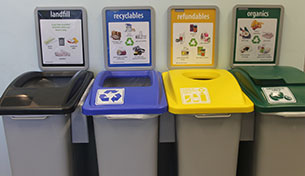 Centralized diversion stations: By placing all the waste bins (recycling, refundable beverage containers, compost and garbage) together in a central hallway, it encourages students and staff to put their waste where it belongs. Students and teachers are responsible for recycling in the classroom, and the facility operator picks up from the centralized stations.
Centralized diversion stations: By placing all the waste bins (recycling, refundable beverage containers, compost and garbage) together in a central hallway, it encourages students and staff to put their waste where it belongs. Students and teachers are responsible for recycling in the classroom, and the facility operator picks up from the centralized stations.
- No-sort recycling: Paper and cardboard, plastic containers, food cans and glass all go in the same bin – echoing The City’s residential Blue Cart program. This makes it easier for students and staff to participate, since the same rules apply both at home and at school.
- Consistent bins used across all schools: Nearly 200 schools received new bins with clear, visual signage to make the recycling program consistent and recognizable across all schools that participate.
- Coordinated paper shredding program: The CBE has strict processes for securing private documents. There is a significant effort to ensure a secure shredding program is in place; shredded paper is then recycled.
- Separate beverage container recycling: Each school collects refundable beverage containers separately and uses the proceeds to support various school-based initiatives.
- Recycling even more: In addition to recycling the items that will be required in the Waste & Recycling Bylaw, the CBE also recycles single-use batteries, fluorescent lights and printer cartridges, library books and textbooks.
- Program sustainability: Creating a best practices document and protocol has helped create a program that is consistent across all schools. Fostering strong relationships with program champions in all schools, and not relying on one individual, has helped increase program sustainability and long-term success.
- Incorporate waste diversion into school culture and educational curriculum: As part of their overall organizational mandate, they’ve incorporated environmental literacy on all levels of education as outlined in their Sustainability Framework and a Three-Year Sustainability Plan (2014-2017). Some of the plan’s highlights include:
- Having dedicated staff focused on sustainability, including a Waste and Recycling Coordinator and a dedicated Sustainability Coordinator;
- Aligning waste management practices with municipal requirements; and
- Supporting sustainability as a focus of inquiry related to all core subject areas taught within CBE schools.
- Having dedicated staff focused on sustainability, including a Waste and Recycling Coordinator and a dedicated Sustainability Coordinator;
Key Challenges
Deborah Wehnes, the CBE’s Waste and Recycling Coordinator, says, “The challenges we had were finding funding and resources to put the equipment in place. We built a business case based on The City’s strategy to divert waste from the landfill. We looked at cost savings based on waste reductions. It’s more economical to recycle than to send it to the landfill. I think other organizations would find the same thing.”
Wehnes adds that developing a best practices document and process created a strong direction for teaching staff, our students, and the facility operator. “We have the direction now that it came from the top. Now it’s consistent across all schools.”
Getting Help
The CBE worked with CH2MHill on a detailed waste audit that helped characterize the types and amounts of waste produced at the schools. Through a literature review, a series of site visits and a survey they helped created an effective waste management strategy for their organization.
The CBE works with a number of partners including Waste Management, Green Calgary, The City of Calgary and Destination Conservation, to help deliver programs and resources to staff and students.
Looking Ahead
Currently, 115 schools are participating in the organics collection program, while Wehnes and her team are working to get other schools on board.
On average, schools that have effective organics programs are able to reduce their total waste going to the landfill by 79 per cent. Paper towel is a great first step for many schools to start diverting organics
Eight new CBE schools are opening in fall 2016, with additional schools slated to open in January 2017. All of these schools will open with complete recycling equipment in order to participate in all CBE programs, including organics collection.
Momentum
Momentum is a local community economic development organization which offers programming in three areas – Business Development, Skills Training and Financial Literacy. All areas work towards their vision: “Every person has a sustainable livelihood and contributes to their community”. Through all of their work with Calgarians, four values influence their operations:
- Integrity
- Compassion and Social Justice
- Equality and Respect
- Sustainability
Momentum has 55 employees and sees anywhere from 30 to 120 program participants coming through their space every day. With that many people moving around the office, it’s not always easy to monitor and continuously improve a recycling and composting program. However, Momentum keeps sustainability at the core of what they do, both around the office and by spreading the message to their program participants.
Program Details
Momentum has programs in place to divert the following materials from the landfill:
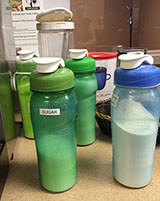 Paper and cardboard
Paper and cardboard
- Plastics
- Glass jars and bottles
- Metal cans and foil
- Refundable beverage containers
- Batteries
- Electronics
- Cell phones
- Paper towels
- Food waste (composting)
In a standard month, Momentum recycles over 450 kg of mixed recyclables and composts over 750 kg of food waste.
Prioritizing sustainability
On the surface, it might not look like sustainability is part of Momentum’s core business. However, they make the connection between their care for the Calgary community, its members and the environment around us. Incorporating sustainability helps empower staff and participants to consider the environment in their decisions and actions to further community economic development.
Momentum has a “Think 3” Initiative that guides the process by which staff make purchasing decisions based on environmental, social and economic criteria. These criteria help empower staff to make purchasing decisions based on the interconnectedness of environmental, social and economic sustainability. There are always tradeoffs that need to be made when making purchasing decisions, but the Think 3 Initiative helps Momentum staff make the most informed decisions about the goods and services they buy. It helps guide the thought process behind making a sustainable decision.
Their sustainability Audit Group, or SAG, includes staff and board members in decision making and implementing programming that continuously improves their environmental performance. SAG is proud to be an Emerald Award Finalist for 2016.
Sustainability monitoring and continual improvement
SAG takes their name seriously – they regularly audit their waste program, along with other aspects of their sustainability program. By continually auditing the success of these programs, they’re able to identify opportunities and improve their performance. When they see an opportunity, they try to act on it.
After doing a greenhouse gas audit, SAG discovered that the biggest contributors to emissions from their operations were from electricity and staff commuting. They became Bullfrog powered to offset their electricity emissions. They also encouraged active commuting, telecommuting and carpooling in order to cut their emissions further. The extra benefit of having fewer staff members’ cars in the parking lot also benefits their bottom line, by paying for fewer dedicated stalls, and benefits their participants, who can park closer to the door when they come for programs.
In addition to conducting waste audits, Momentum makes sure to keep open communication with their recycling hauler, BluPlanet Recycling. This allows Momentum to utilize the information that BluPlanet staff collect when they’re picking up the recycling – such as contamination of recyclables.
How they did it
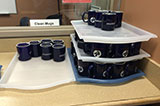 Recycling and composting bins are placed throughout the office and typically as a group, rather than having a garbage bin on its own.
Recycling and composting bins are placed throughout the office and typically as a group, rather than having a garbage bin on its own.
- Bins have signs that show words and pictures of what goes into them (as well as common mistake items that don’t belong there).
- Momentum has enough mugs, cups, plates and cutlery necessary to ensure that disposable food ware is never used in the office. By reusing these items, they’re taking environmental sustainability a step further than recycling or composting.
- All staff are responsible for completing assigned chores each week. By working together on waste and recycling, as well as other cleaning duties, all staff are involved in the program. Dishwasher duty is assigned, which supports the use of reusable dishware throughout the office. This kind of program supports many of the environmental initiatives at Momentum.
- Momentum boasts a team that is passionate about social and environmental justice. Incorporating employees’ interests and passion about the environment helps strengthen Momentum’s sustainability programs.
- As with many businesses, cost doesn’t stray too far from SAG’s mind. All committees at Momentum have an assigned budget, so cost analysis is central to SAG’s decision making process. If a new initiative is identified as important, Momentum finds a way to make the budget work.
Spreading the word
New staff participate in a series of training and orientations when they join Momentum. There is a specific orientation about the work of the Sustainability Audit Group, including a tour.
It’s an ongoing process to ensure that Momentum’s participants and guests use the recycling and composting programs properly. Some ways they educate people coming in and out of the office include:
- Giving new participants a full overview and tour of the programs that are available, especially for participants who are registered in long-term programs;
- Program facilitators include slides in their PowerPoint presentations to show the recycling and composting programs; and
- Showing leadership and developing social norms that encourage staff, participants and guests to use recycling and composting programs appropriately.
Momentum shares their value of sustainability by living it and teaching it to participants in their programs. They offer classes on sustainability in business in certain programs, and encourage participants to make connections between individual and community efforts. For example, the cleaning company that Momentum uses was started by a former program participant who chose to use greener cleaning products in their business.
Momentum has also recently been spreading the word by hosting other non-profit organizations at their site for a sustainability learning tour. By sharing their expertise and how they’ve dealt with challenges, Momentum helps other organizations along their sustainability journeys.
Key challenges
When it comes to waste diversion, Momentum experiences challenges similar to many other businesses – sometimes items make their way into the wrong bins.
At staff meetings, SAG members share opportunities for environmental improvement. Once staff are aware of possible improvements, they pass the message along to the program participants and guests they host in the office.
There is also an opportunity during staff meetings to brainstorm ideas about how to deal with challenges and to maintain continuous quality improvement. As part of these discussions, staff requested learning opportunities around recycling. SAG was able to offer a series of hands-on demonstrations of recycling stations and items that are often recycled incorrectly, to support staff integration of composting and recycling services at the office.
Some common challenges in Momentum’s sustainability program include napkins and paper towels not going into the compost, where they should be, and paper coffee cups going in the recycling bin instead of the garbage.
Beyond recycling
Greener commuting is a big focus for SAG. They encourage employees to bike to work and support this by having two showers in the office, a bike rack inside the office and an additional bike rack out front. They also host commuting challenges. In June the SAG group launched their Commuter Bonus program, a daily dollar amount added to employees’ paycheques for every day they do not drive to work.
They also offer a carpooling program that helps employees ride to work together instead of driving separately.
Where possible, more environmentally-friendly cleaning products are used, such as a vinegar/water mix. They’re currently switching to a greener dishwasher detergent that’s made in Quebec. Switching to a more environmentally-friendly product that is made in Canada reflects Momentum’s values.
An outdoor garden for people to connect with nature and a yearly Earth Day litter pickup in partnership with the International Avenue BRZ also contribute to good green vibes around the Momentum office and across the community.
Going forward, Momentum is considering the removal of waste bins at individual work stations, to encourage employees to get up from their desks to throw away garbage. They’re also determining how to further reduce the number of cars brought to their parking lot, possibly by supplying their staff with bus passes, and by continuing programs like the Commuter Bonus program.

